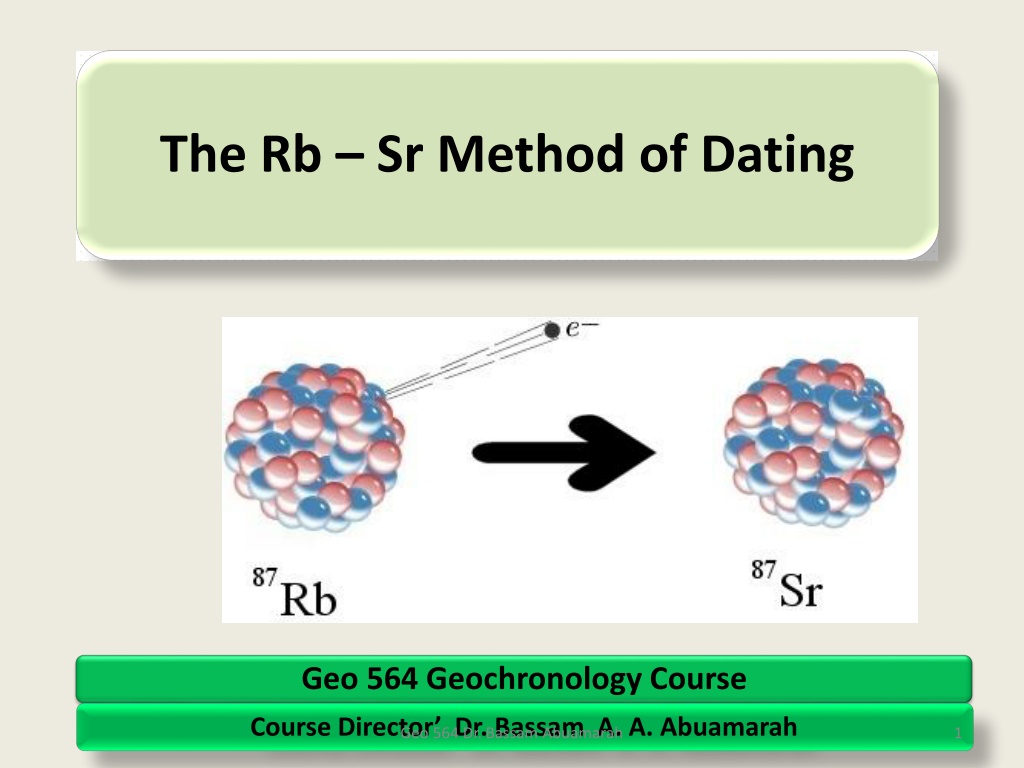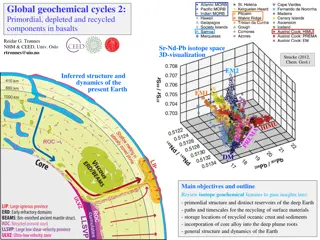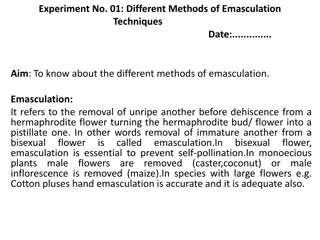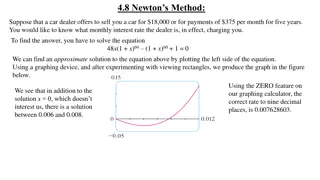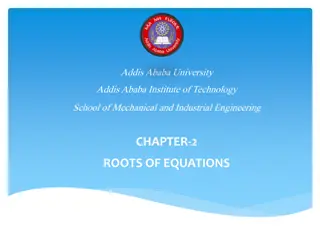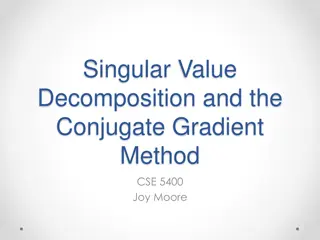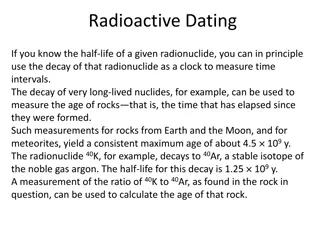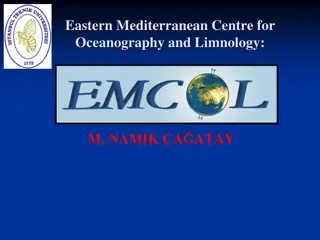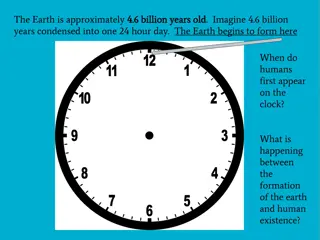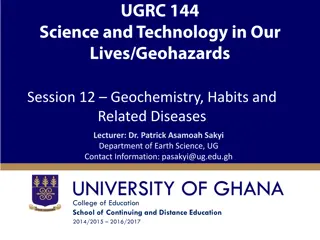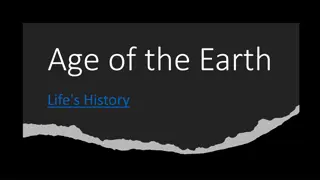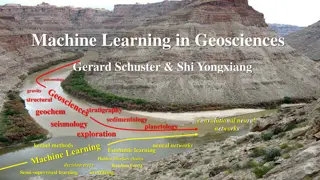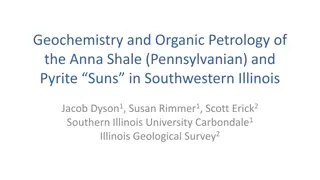The Rb-Sr Method of Dating in Geochemistry
Explore the principles of the Rb-Sr dating method in geochemistry, focusing on radioactive decay of Rubidium and Strontium isotopes in geological materials. Learn about isotope data presentation, application in dating geological processes, and the significance of Rb and Sr in the periodic table.
Download Presentation

Please find below an Image/Link to download the presentation.
The content on the website is provided AS IS for your information and personal use only. It may not be sold, licensed, or shared on other websites without obtaining consent from the author.If you encounter any issues during the download, it is possible that the publisher has removed the file from their server.
You are allowed to download the files provided on this website for personal or commercial use, subject to the condition that they are used lawfully. All files are the property of their respective owners.
The content on the website is provided AS IS for your information and personal use only. It may not be sold, licensed, or shared on other websites without obtaining consent from the author.
E N D
Presentation Transcript
The Rb Sr Method of Dating Geo 564 Geochronology Course Course Director Dr. Bassam A. A. Abuamarah Geo 564 Dr. Bassam Abuamarah 1
The Rb-Sr method of Dating - Introduction We will learn how the Radioactive decay Of Rb is confined in the geological materials (i.e rocks, minerals.. Etc), that can be used to date the geological processes, via the following topics: I. We will have a brief notes on the geochemistry of Rb and Sr . II. Nature of occurring the Rb and Sr Isotopes III. Radioactive decay of Rb and the growth of 87Sr. IV. Graphical presentation of isotope data is called Isochron diagram V. Application on the use of the method to date magnetism and metamorphism and sedimentation 2
Rb and Sr in the Periodic Table 2nd 1st Increasing in Ionic Radius (sizebigger Atomic Mass column column 87 Rb 1 H 38 3 Li 4 Be 11 Na 12 Mg Proton (P+) Neutron (N) Atomic Number 37 19 K 20 Ca Neutral atoms of the alkali metals are characterized by 1 electron in outer shell, therefore, they are monovalent ions. 37 Rb 38 Sr 55 Cs 56 Ba K1+ K 87 Fr 88 Ra 1.33 These elements commonly form divalent ions. Rb Rb1+ Ca Ca2+ Ca radii 1.32 1.48 Sr2+ smallest Sr 3 bigger ionic radii 1.32
Thus, The Periodic table arranges the chemical element upon their Atomic Number, and electron configuration, and then elements are presented according to the increase in atomic number horizontally. The Atomic Radius is the distance from the atomic nucleus to the outermost Electron Orbital in the Atom. In general, the atomic radius decreases as we move from left to right in a period, and it increases when we go down a group. 4
This is because, in periods, the valence electrons are in the same outermost shell. The atomic number increases within the same period while moving from left to right, which in turn increases the effective nuclear charge. 5
Contd: Rb and Sr in the Periodic Table Thus, Rubidium (Rb) belong to alkali metals (column 1 above) which also include Sodium (Na) and Potassium (K). and Strontium (Sr) belong to the earth alkali metals Column 2 , which include Magnesium (Mg) and Calcium (Ca) Thus, the ionic radii of the alkali elements increase towards higher atomic number. The ionic radii of Rb (1.48 ) is of K ( of K (1.33 1.33 ) ) to allow Rb to substitute for K to allow Rb to substitute for K in all K minerals minerals. . ) is sufficiently sufficiently similar to that in all K- -bearing similar to that bearing 6
Contd: Rb and Sr in the Periodic Table Thus, minerals suitable or used for the Rb-Sr method dating rocks which involve the following minerals: K-feldspar Micas Clay minerals and Evaporate minerals such as sylvite and Carnallite The ionic radius of Sr is slightly larger than of that Calcium (Ca), which can replace it in many common minerals, such as plagioclase, apatite and calcite 7
Rb) is stable Cont d: Rb and Sr in the Periodic Table Y 85 Sr 84 Rb 83 K 82 46 Y 86 Sr 85 Rb 84 K 83 Y 87 Sr 86 Rb 85 K 84 48 Y 88 Sr 87 Rb 86 K 85 Y 89 Sr 88 Rb 87 K 86 Y 90 Sr 89 Rb 88 K 87 39 # of protons 38 37 36 49 47 50 51 # of Neutrons Rb has 2 natural occurring isotopes (87Rb) and (85Rb) (87 Rb) is radioactive, whereas the (85 Rb) is stable Sr has four natural occurring isotopes, which all are STABLE Sr 84, Sr 86,Sr 87,Sr 88 8
Contd: Rb and Sr in the Periodic Table Atomic Mass 87Sr 38 87Rb Atomic Number 37 87 Rb Thus, from the above The 87Rb nucleusconsists of : 37 protons ,and 50 neutron. Thus, 87Rb is unstable and it radioactive decays to 87Sr., by emitting particles: 9
The decay Mechanism 87Sr 87Rb 87 Sr i.e. one neutron of the nucleus transform to PROTON by emitting a ( ) particles , and releasing antineutron ( ). The results the87Sr nucleus consist of 38 PROTONS and 49 NEUTRONS, which corresponds to 87Sr. The decay of 87Rb to stable 87 Sr is described as follows the formula: 87Rb = 87 Sr + + + Q Where = represents the Beta Particles or neutrons, is the antineutron, and Q = is the decay energy released during the decay reactions 10
Radioactive Decay of 87Rb and the growth of 87 Sr 87Rb # of Atoms 87SR 87Rb Time 87Rb has a half-life (T ) = 4.88 X 1010 years, which corresponds to the decay constant = 1.42 X 10-11 y-1 And Half-life = (T = 0.693/ ), For instance; the above right box filled with 32 atoms of 87Rb . Thus, what will happen to 87Rb atoms as years passed by? 11
Radioactive Decay of 87Rb and the growth of 87 Sr 87 Rb 9.76 4.88 24.40 # of Atoms 19.52 14.64 87Rb & 87Sr 87 Sr Time Ga After 4.88 billion years half-life of the 87 Rb atoms of that initially was found in the box have decayed via radioactive processes to 87 Sr This range in time corresponds to one half ( ) of the initial 87 Rb found in the box And then 12
87Rb/87Sr Decay Scheme In nature: 87Rb=27.83 % 85Rb= 72.17 87Sr by emitting B Half-life = 48.8 Billion years 88 Sr = 82.53% 87 Sr= 7.04% 86Sr=9.87& 84Sr==0.56% 13
Contd: Radioactive Decay of 87Rb and the growth of 87 Sr Thus, for every 4.88 billion years the number of 87Rb will be halved, and the number of 87 Sr increases (growth) accordingly. As a result, after a period of 5 half-lives, only 1 atom of 87Rb will remains in the box. So, the number of 87 Sr atoms found in the box is 31 atoms 14
Contd: Radioactive Decay of 87Rb and the growth of 87 Sr Thus, 87 Sr and 87Rb represent the number of the respective isotope atoms in the box TODAY., 87Sri represents the initial content of the 87Sr in the box( Zero in the example above) So the equation can be arranged as follows: t = (1/ ) ln (87Sr 87Sri) / 87 Rb) + 1 We fill the numbers that are known: t= (1/1.42 X 10-11 y-1) ln (31 0.0i / 1) + 1 The age is t= 24.4 years 15
Contd: Radioactive Decay of 87Rb and the growth of 87Sr So How do we calculate the age ? The tool we are going to use for Rb-Sr method of dating is applying the following equation 87Sr = 87Sri + 87Rb ( e t 1) Where : 87Sri represents the initial content of the 87Sr in the box( Zero in the example above) 87 Sr and 87Rb represent the number of the respective isotope atoms in the box TODAY 16
The Fundamental Equation 87Sr = 87Sri + 87Rb ( e t 1) therefore if we know how many87Sr atoms were incorporated in the mineral at its formation or initiation time (87Sri), then we have to analyses the percentage (Ratio) (%) of the 87Rb and 87Sr content in the mineral (Concentration). So as to calculate the age of the mineral (i.e. the rock) the equation above will be applied: 17
Contd: The Fundamental Equation Practically, the concentration of the isotopes as input is required to apply the above equation. Mass-spectrometry, is the instrument that performs an isotopes analyses by giving isotopes ratios as an output, So, in order to have the ratio; we have to DIVIDE THE BOTH SIDE OF THE EQUATION (1) BY 86Sr as a stable isotope, So, the equ. Becomes: 87Sr/86Sr = (87Sr/86Sr)i + 87Rb/86Sr( e t 1)Equation 1 18
Contd: The Fundamental Equation and 86Sris not produced by decay, it is a naturally occurring isotope of other elements. Thus, the 86Sr content in the mineral does not change with time. The equation 1 is considered as source for age calculation by using Rb Sr method I believe before we apply this equation, we have to have an idea about using ISOCHRON DIAGRAM, and have some of its basic mathematics , in order to be used for 19
Mathematics used-The Isochrom Diagram Equation 2: 87Sr/86Sr = (87Sr/86Sr)i + 87 Rb/86Sr ( e t 1) When you crystallize a rock, you will always have some Sr Presented Measured Measured Isochron is a line plotted in X-Y diagram, The equation used for this line is Y = 1 + 0.5 X Y = A + X K Y axis slope This line intersect with Y axis at y = 1= A, the slope of the line is 0.5 = k Thus, the general expression for a line in X-Y diagram is Y =A + XK (linear equation) (A) point corresponds to the point of intersection between line and Y-axis, while K corresponds to the slope of the line. Y = 1 + 0.5 X X axis 20
The Isochrom Diagram Y = A + X K 87 Sr/86Sr =(87Sr/86Sr)i + 87 Rb/86Sr ( e t 1) 87 Sr/86Sr 87 Rb/86Sr Now, let us compare the Equ. 2 With the general equation for a line of a X-Y diagram. On the basis of equation 2, we can plot a diagram with 87Rb/86Sr along the horizontal axis (x-axis), and 87Sr/86Sr along the vertical axis (Y-axis) 21
The Isochrom Diagram In this diagram, equation 1 represent a line : 87Sr/86Sr =(87 Sr/ 86Sr)i + ( 87Rb/86Sr) ( e t 1) Isochron diagram shows value of (87Rb/86Sr) plotted along on the horizontal axis (X-axis), while the values of 87Sr/86Sr plotted along the vertical axis (Y-axis). (87 Sr/86Sr)i 87 Sr/86Sr And 87 Rb/86Sr 22
Contd: The Isochron Diagram The values of (87Sr/86Sri)as initial content corresponds to the points of intersection between the line and the vertical axis (Y-axis), while ( e t 1) value corresponds to the slope of the line. 23
Dating of igneous Rocks Now we will take a look at the results of Rb-Sr isotopes. of the a geological map of the granitic area showed 87Sr/86Sr =(87Sr/86Sr)i + (87 Rb/86Sr) (e t 1) 0.77 87 Sr/86Sr In the diagram 7 samples of the granite were prepared for the analyses by a Mass-Spectrometry: 0.76 0.75 0.74 0.73 0.72 (87 Sr/86Sr)I = 0.70404 0.71 070 87 Rb/86Sr 24
Contd: Dating of igneous Rocks Samples 1 & 2 were biotite poor granite, 3 to 5 were characterized by intermediate biotite content, while samples 6 & 7 were rich in biotite mineral. When the analyses had been carried out, the data were plotted in the diagram, as shown above. Note: that the Rb content of the samples correlates with the biotite contents of the rocks, why? 25
Contd: Dating of igneous Rocks A line can be drawn through the data points. The line intersects with the vertical axis (Y-axis) at the value of 87 Sr/86Sr = 0.70404. 87 Sr/86Sr 0.77 0.76 7 0.75 0.74 This is corresponding to the 87Sr/86Sr ratio of granite (and all minerals it is composed of) immediately after formation. 2 0.73 1 0.72 (87 Sr/86Sr)I = 0.70404 0.71 070 87 Rb/86Sr The slope of the line gives us the equation ( e t 1) = 0.02523 in this equation there is only an unknown, namely (t) (Time), which can be found by solving the equation. 26
Contd: Dating of igneous Rocks The line in this diagram is called a ISOCHRON, which mean similar age In the ISOCHRON Diagram, rocks and minerals of the similar age plot along a single-an Isochron 27
Contd: Dating of Igneous Rocks 1. When the granite crystallized all minerals in the rocks get the same value of 87Sr/86Sr ratio = (0.70404), Becausethey all formed from the same isotopically homogenized magma. The slope of the isochron was Zero which corresponds to the age = Zero The bottom line; High Rb/Sr contains more 87Sr Low Rb/Sr contains less 87Sr 7 2 6 0.74 5 0.73 4 23 1 0.71 1 0.70 0.69 1.0 2.0 3.0 4.0 Sample with higher Rb Sample with lower Rb 28
Contd: Dating of Igneous Rocks 2. (Line 2 )In the diagram above: Since the time of the crystallization, atoms of 87Rb have continuously undergone radioactive decay to 87Sr. In rocks with initial low content of 87Rb, They relatively have a small amount of 87SR formed. 0.79 0.78 0.77 0.74 0.76 87Sr/86Sr 0.75 0.74 0.73 0.72 0.71 3.5 0.5 1.52.02.53.0 87Rb/86Sr 4.0 1.0 87Sr/86Sr = (87Sr/86Sr)i + 87Rb/86Sr(e t 1)Equation 1 29
Contd: Dating of Igneous Rocks In the rocks which initially contained more 87Rb, it proportionally showed a higher amount of 87Sr formed. Note: Seven samples were plotted on a line at any stage, during the evolution of the rocks. This line is hinged to the vertical Y- axis, at the value of (87Sr/86Sr). The slope of the line increases as time goes by present slope indicate that the Granite is 1.706 Ma old 30
Contd: Dating of Igneous Rocks 87Sr/86Sr ratios for igneous Rocks: MORB = 0.7025 Continents = Oceanic Island = Meteorites = Rb/Sr =0.8 87Rb/86Sr ratios for Various Rocks are: Ultra basic = 0.2 Basaltic = Granite = Shale = Sandstone = 3 0.7119 0.704 0.699 0.06 0.25 -1.7 0.46 Rb/Sr =1.2 Rocks 87Sr/86Sr = 0.702 Rb/Sr =0.6 Mantle 87Sr/86Sr = 0.702 32
Dating of Metamorphic Rocks R 2 0.77 2 0.76 0.75 0.74 87Sr/86Sr 0.73 3 M 1 M 3 R 1 1)line 1: Now M 2 R 3 0.72 0.71 1 we will focus on how the Rb-Sr methodcan be used to date metamorphic rocks, The mountain on the lift Is composed of metamorphic igneous rocks (R), while M1, M2, and M3 the red circle represent three minerals contained in R2 0.70 1.0 R 1 3.0 2.0 M 1 M 3 R 2 R 3 M 2 87Rb/87Sr 33
Contd: Dating of Metamorphic Rocks The diagram to the right shows the isotopic composition of the rock volumes and the minerals formed shortly after crystallization Both the rocks volume and minerals show the same 87Sr/86Sr ratio, since they all formed in the same ISOTOPICALLY homogenous melt. 34
Contd: Dating of Metamorphic Rocks The 87Rb/86Sr ratios, however, are different because various minerals fractionate Rb and Sr differently. 2) Line 2 formed due to, after, 1000 Ma, the line will be hinged as shown in the above diagram. i.e. during the period of 1000 Ma, the slope of the Isochronincreases in response to the RADIOACTIVE DECAY of 87Rb and the growth of 87Sr. 35
R 2 Cont d: Dating of Metamorphic Rocks 3) Line 3 : Then the rock was heated (in the diagram) under metamorphic events of short duration, R 1 M 1 M 2M 3 R 3 The increased temperature (T o) led to a mobilization of Sron a small scale (between the minerals of a piece of the rock), which resulted in an ISOTOPIC HOMOGENIZATION of minerals in the sample of R2 36
Contd: Dating of Metamorphic Rocks However, the mobility of Sr was not large enough to homogenize larger volume of the rock. After cooling, the Sr was immobilized, and 87Sr/86Sr ratios continued to evolve in the minerals and rocks volumes. 0.78 0.77 0.76 R 3 0.75 87Sr/86Sr M1 M3 M2 0.74 0.73 tm= 500 Ma R 2 The age 1500 Ma, after the crystallization of the rocks specimen define an ISOCHRON that gives the of the crystallization of the rocks (t). 0.72 0.71 R 1 0.70 1 3 2 4 87Rb/86Sr 37
The ISOCHRON defined by the sample R2 and the 3 minerals from R2, However it gives the age of the metamorphic event, which occurred 500 Ma ago as (tm) 0.78 0.77 0.76 R 3 0.75 87Sr/86Sr M1 M3 M2 0.74 0.73 tm= 500 Ma R 2 0.72 0.71 R 1 0.70 1 3 2 4 87Rbr/86Sr 38
Dating Of Sedimentary Processing using Sr isotope of Marine Carbonate Many Organisms living in the Ocean water have shells or Hard parts that are made of CaCO3. As we know the Sr2+ is a divalent element and the Ca 2+ has similar charges and Ionic Radii, Consequently, the Sr2+ is readily substituted for the Ca2+ cation in the carbonate structure. Rb, however, is not incorporated in Carbonates The 87Sr/86Sr ratio in the carbonaceous shell of a living organism is similar to the 87Sr/86Sr ratio of the water living in. 39
Contd: Dating Of Sedimentary Processing using Sr isotope of Marine Carbonate Consequently, when the organism died and is incorporated into the bottom s sediments of the sea, the 87Sr/86Sr signature belongs to the environment it was living in and is preserved in the sediments that formed. i.e. since the shell does not contains Rb. So, the 87Sr/86Sr signature is not altered with time Conclusion: The marine Carbonate can be used only to monitor the variation in 78Sr/86Sr of the Ocean water throughout the time 40
Sr isotopes of the mantle and the crust Mantle Crust Now, let us have a quick look at the 87Sr/86Sr ratios of the Earth s crust and Mantle. Since the formation of the earth 4.6 Ga ago; The mantle has been homogenous with respect to the 87Rb/86Sr and 87Sr/86Sr ratios. 0.710 0.708 87Sr/86Sr 0.706 0.704 0.702 0.689 Present 1 3 2 4 87Rbr/86Sr 41
Contd : Sr isotopes of the mantle and the crust Shortly, after the formation of the earth, the 87Sr/86Sr ratios of the Mantle was about 0.699. 0.710 The reason is that of the RADIOACTIVE DECAY of 87Rb to 87Sr, and due to 87Sr/86Sr ratios of the mantle. The mantle has evolved to present an 87Sr/86Sr value of about 0.704, 0.708 87Sr/86Sr 0.706 0.704 0.702 0.699 Present 1 3 2 4 87Rbr/86Sr 42
Contd : Sr isotopes of the mantle and the crust Formation of new crust Partial melting and During the partial melting of the mantle. Materials extracted from the mantle and added to the Earth s crust; Immediately after the formation of the new crust, its Sr isotopic compositionis similar to the composition of the mantle it was extracted from 43
Contd : Sr isotopes of the mantle and the crust Formation of new crust During the partial melting of the mantle, Rb is partitioned, and segregated into a melt relative Sr. This happened immediately after its formation; the newly formed crust shows a high Rb/Sr ratio than the mantle it was extracted from. Partial melting 0.710 0.708 87Sr/86Sr 0.706 0.704 0.702 0.689 Present 1 4 3 2 87Rbr/86Sr 44
Contd : Sr isotopes of the mantle and the crust Similarly, the part of the mantle that has undergone partial melting ( it is depleted; i.e. quantity not able to fulfil) shows a lower Rb/Sr ratio than the un-depleted mantle, Formation of new crust Partial melting 0.710 0.708 87Sr/86Sr Because and due 0.706 0.704 Present 0.702 to the differences in their Rb/Sr ratio, the 87Sr/86Sr ratios of the crust 0.689 1 4 3 2 87Rbr/86Sr
Contd : Sr isotopes of the mantle and the crust The depleted (no longer sufficient) and un-depleted mantle evolved differently. So, crustal rocks show , in general, considerably higher 87Sr/86Sr ratios than mantle rocks The Mantle is; as pointed out on a previous slide homogenous concerning its Sr isotope composition. 46
Contd : Sr isotopes of the mantle and the crust Different components of the earth s crust , and ; however; show large vartion in the ratios of 87Sr/86Sr 0.710 C A B 0.708 87Sr/86Sr 0.706 C The reason for this is that the various components of the crust have been extracted from the mantle at a different time as shown in the diagram 0.704 B A 0.702 0.689 1 4 3 2 Present 87Rbr/86Sr A C 47 mantle Partial melting
Sr Isotope source of the Oceans The Sr of Marine water is derived from 3 principles sources: 1. Water on the crust 87Sr/86Sr signature that enters the sea via rivers, and runoff water. Sea level Sr from continent crust Carbonate Sr from marine Sr from mantle 2. Water from mantle 87Sr/86Sr signature that enters the sea through the hydrothermal system along the Mid-oceanic ridge (MORB), and 3. Recirculation of Sr from Pre-existing Carbonate rich rocks 48
Sr Isotope of the Oceans Although the ocean of the world continuously receives Sr of high variable isotopic compositions from the source mentioned above. The isotopic composition of the Oceans are everywhere the same of: 87Sr/86Sr = 0.70924 The strong current of the Ocean s waters is very important for the isotopic homogenization of Sr on a Global Scale. Equally important is, however, the high Sr solubility in marine waters 49
Sr Isotope source of the Oceans Sr that is introduced to the SEA from external sources exist in for sufficiently long time in the sea to homogenize isotopically on a global scale. Less soluble elements such as (Nd) participate long before the global isotopic homogenization is attained Modern ocean water 87Sr/86Sr = 0.70924 0.7095 0.7090 0.7085 87Sr/86Sr = 0.7082=25Ma 87Sr/86Sr = 0.7076=75 &200 Ma 87Sr/86Sr 0.7080 0.7075 0.7070 0.7065 25 50 75 100 150 50 200 Age Ma
